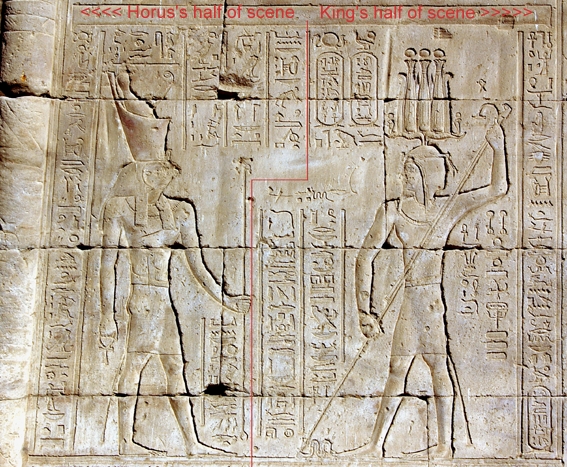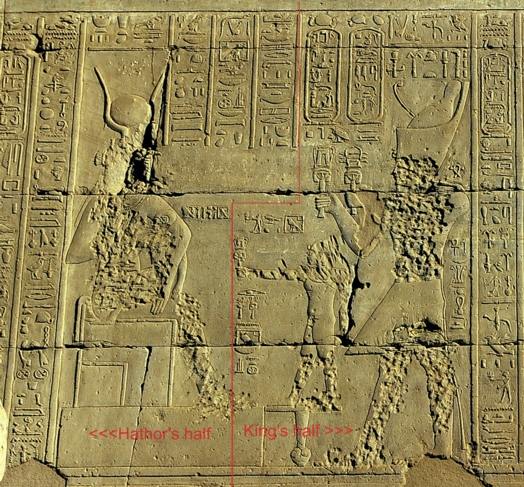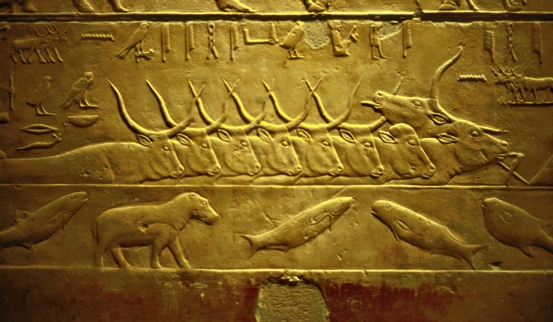Sacred Signs : 3
Sacred Signs : 3

3.1 Shaat-cake offering from the Barque Shrine of Senwosret I at Karnak.
The king, stands on the right, facing Montu, on the left and he says, ‘Giving Shaat-bread, in order that he may achieve the state of one who is ‘given life’. Th text is written underneath his hands.
Above the king and in front of his face there are his name and titles, ‘King of Upper and Lower Egypt; Lord who performs the rituals, Sekhem-wadj Khau-Re, given life and stability like Re’.
Above the king and in front of his face, reading towards him like a speech balloon, the god replies: Words spoken, ‘I give to you life and power.’ Words spoken, ‘I give to you all stability’.
Then his name is written in front of his plumed crown: Montju
His titles carry on behind him: ‘Lord of Thebes, who lives in Madu (Medamoud). May he give everything that is good which is in the land of the lily and the papyrus’.

3.2 Spearing Apopis Ritual from the Mammisi of the Temple of Edfu
The king stands to the right, wearing the hmhmty-war crown. He holds a spear or harpoon with a small head of Horus at the end and to which is attached a rope and float. The king impales the head of a serpent at his feet.
His name is written in cartouches above and in front of his head: (left cartouche) King of Upper and Lower Egypt, (Heir of the beneficent gods, whom his mother loves, avenger of his father, chosen of Ptah, who does the maat of Re, living image of Amun) Son of Re, (Ptolemais), living forever, beloved of Ptah (Ptolemy IX)’. Underneath he is further described as Philometor ‘The god who loves his mother’.
Behind the king are a series of protective phrases and emblems:
‘All life and power are behind him, like Re forever.’
‘Two circuits, the circuit of the two heavens, who opens the throat, who unites the lands’.
The vertical line of text behind the king describes his role in the ritual:
‘Perfect, living god, son of he who is raised upon his perch, who makes a slaughter of the enemy of his father, who slays the serpent. He has stabbed the burning-snake. Lord of might, son of Re Ptolemaios, living forever, beloved of Ptah’.
The ritual action is described in the columns of text between the figures of the king and god:
Slaying Apopis.
Words spoken, ‘Apopis is slain. The Winged Disk is safe in his shrine nearby. Your throne is raised up to you; the two heavens are yours, your sun boat is in joy’.
The king gives a reward to the king in a vertical line of text directly written in front of him:
‘I give to you your enemies in a great massacre’.
Above in a line of text beside the royal cartouche:
‘I give to you your enemies fallen down on the slaughter block’. Words spoken by Horus Behdet, the great god, Lord of heaven. ‘It is the Son of Re who slays his rebels. He is mighty against his enemies. King of Upper and Lower Egypt, Re who made the two heavens, who makes fall the enemy xxxxxxx, heaven is raised up twice xxxxxxx’. Horus Behdet, the great god. Lord of Heaven.’

3.3 Offering the sistra from the Mammisi of the Temple of Edfu
In ths scene Ptolemy IX offers two different kinds of sistra to Hathor. Sistra were musical instruments especially associated with the cults of goddesses. Their rattling sound was used to soothe and pacify angry goddesses such as Sakhmet, the raging form of Hathor.
Here the king is accompanied by Hathor’s child, Ihy the Great son of Hathor.
‘Playing the sistra for Hathor, Lady of Dendera’.
The king is described as: ‘Offshoot of Sakhmet, who makes well the people. Powerful one among the power of the gods’.
The King of the Two Lands (First cartouche) is upon his throne, pacifying her Majesty with the sistrum. He is the good musician, who makes well the people, Ihy for his mother, as she wishes.
The goddess Hathor is seated nursing her son Harsomthus. She grants the king his reward:
‘I put awe of you in men, love of you in women’. Words spoken by Hathor, the Great, Lady of Dendera, Lady of Heaven, Mistress of all of the gods, the Eye of Re, without her equal in heaven and earth. Great of Love, Mistress of Women.
The Noble lady, the Powerful woman appears in Behdet filling heaven and earth with her beauty. She is the female sun god. Mistress of the Upper and Lower Egypt, who makes wide the course of the sun boat for millions ///’.
Hieroglyphic labels for scenes to complete their meaning

3.4 Ti Cattle fording a stream.
This Old Kingdom scene shows cattle in a water course which also contains a hippopotamus and some fish. The text above them is a plea for their protection:
O Herdsman, give the shelter of Horus to the cattle’.
